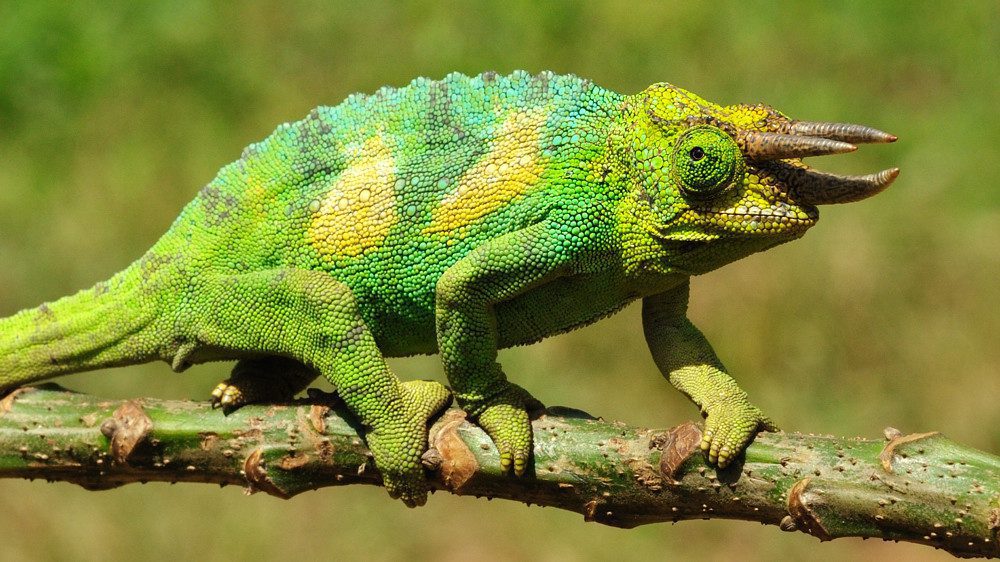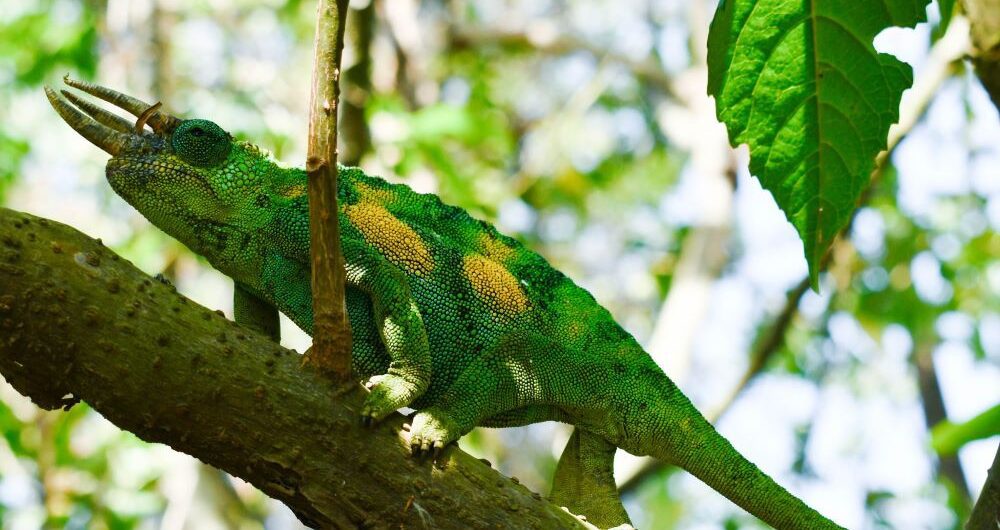Three-horned chameleons in Bwindi: The Bwindi Impenetrable Forest National Park, located in the southwest of Uganda, is home to the critically endangered mountain gorillas. Among its many attractions are nature walks, birding, and community tours. The endangered three-horned chameleon can be found in the Bwindi Impenetrable Forest National Park. The Kikuyu three-horned chameleon or Jackson’s chameleon are other names for the three-horned chameleons.
They are a species of chameleon that originated in East Africa and are members of the Chamaeleonidae family; nevertheless, they were brought to California and Hawaii through introduction. There are a few locations in Uganda where one can find three-horned chameleons, and these include the Rwenzori Mountains National Park and Bwindi Impenetrable Forest National Park.
Because the males have three brown horns on their heads, they were given the name “three horned chameleons.” Male three-horned chameleons have three horns, one on the nose and the other two on each eye; females lack horns. Males of the same species fight each other using their horns.
Because they live in areas with lush vegetation, three-horned chameleons in Bwindi are typically green in color. However, like other chameleons, their color can vary according to factors like mood, health, and temperature. The female three-horned chameleons grow to a length of 25 cm, while the males reach a total length of 38 cm. Though their lifespans differ, male chameleons live longer than females.
At nine months of age, the female three-horned chameleon reaches sexual maturity. Three-horned chameleons carry their eggs inside their bodies, where they hatch into a thick sack, in contrast to other chameleons that lay off their eggs. About 20 to 30 offspring are produced by a brood of three horned chameleons after a five to six month gestation period. Three-horned chameleon babies are independent from the moment of birth, and females can reproduce in as little as 20 days after giving birth. It will take the younger ones nine months to start acting sexually.
Three-horned chameleons in Bwindi are threatened by birds, snakes, lizards, and certain mammals. If they manage to elude these predators, males can live up to ten years, while females can only live up to eight. In Bwindi, three horned chameleons can be observed residing in the 1600–2400 ft. altitude tropical forests. Using their long, sticky tongue to catch prey, they feed on a variety of invertebrates, such as flies, insects, millipedes, centipedes, roaches, mealworms, crickets, spiders, and much more.

Although three-horned chameleons are not venomous or poisonous, you should never eat one. They are quite calm, but if handled incorrectly, they may bite or hiss, which can be quite painful. It is possible to track and come across three-horned chameleons by visiting the Bwindi Impenetrable Forest National Park.
Best time to visit Bwindi impenetrable forest national park?
Although there are months that are better than others, visitors who want to see three-horned chameleons in Bwindi can visit the park at any time of year. The best times to visit the park are during the dry months of June through September and December through February, when there is little to no rainfall that leaves the trails dry, the vegetation is short, making it easier to spot chameleons, and the park’s roads are in good condition.
While three-horned chameleons can still be seen in Bwindi during the rainy season (March to May and October to November), this is better for budget travelers as the lodges are less expensive. However, the excessive amount of rain that characterizes the rainy season makes the trails muddy and slippery, the tall and dense vegetation makes it difficult to find the chameleons, and the roads that connect to the park are in poor condition.
Accessing Bwindi impenetrable forest national park?
In order to reach Bwindi Impenetrable Forest National Park, which is home to mountain gorillas and three-horned chameleons, one must travel from Kampala via Masaka, Mbarara, Kabale, Kisoro, or Kanungu, taking approximately 9 to 10 hours. Using Katuna birder in Kabale or the Cyanika border in Kisoro, it takes four to five hours to get from Kigali to Bwindi. If luxury travelers fly from Kajjansi airstrip or Entebbe international airport to Kihihi airstrip or Kisoro airstrip to any of the park sectors, they will need approximately hours to reach Bwindi.
Accommodations in Bwindi impenetrable forest national park
Travelers visiting Bwindi Impenetrable Forest National Park have access to a wide variety of lodging options for their stay. These lodging options, which range from low-cost to luxurious, are located throughout the park in various areas. Where you stay will depend on your budget.
A few of the lodging options in Bwindi are the following: Ride 4 Women Guest House, Four Gorillas Lodge, Nkuringo Bwindi Gorilla Lodge, Ruhija Gorilla Safari Lodge, Nshongi Camp, Agandi Lodge, Bakiga Lodge, Buhoma Lodge, Rushaga Gorilla Lodge, Engagi Lodge, Ichumbi Gorilla Lodge, and so on.
Some of our trips you may join to have a chance to see them.
10 Days Uganda Wildlife Safari With Mountain Gorilla Trekking Excursion


Comments